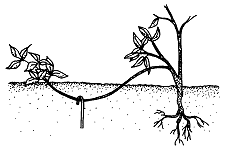How to Use Layers in Affinity Designer
Nicolette Goff is a watercolourist, writer, and dedicated gardener. Her books, articles and paintings reveal her love of nature.

Blackberries will layer naturally, forming mats of brambles.
BigStock Photos
What is Layering?
Some Saturday morning this spring or early summer, take a few minutes to produce some new shrubs from your favorite ones by layering. You can layer to propagate berry bushes such as currants and gooseberries, bramble fruits like raspberries and blackberries, and even grapevines. If you'd like to expand your groundcover, then start new plants of pachysandra or periwinkle by layering.
Ornamental Shrubs to Consider for Layering
| Barberry | Escallonia | Daphne |
| Flowering Quince | Forsythia | Lilacs |
| Magnolias | Mock Orange | Shrub Roses |
| Viburnum | Wisteria | Azaleas |
| Rhododendrons |
Many of these plants layer naturally when a low branch happens to touch the ground and roots sprout. I've given away several rosemary bushes that naturally layered. My new escallonia plants, created by unintentional layering, are ready to transplant to a new location.
So, why not propagate intentionally and expand your collection of favorite cultivars?
Other Good Candidates for Layering
Another form of natural layering is plants that send out stolons, such as strawberries, ajuga, and spider plants; or plants that have offsets, such as bananas, many bromeliads, and hens and chicks.
Methods of Layering
- Simple Layering
- Trench Layering
- Compound Layering
- Tip Layering
- Mounding
- Air Layering
Unlike cuttings, a layered branch is nourished by the parent plant while the roots are forming, so timing isn't as critical. The best time, however, is during early spring or summer, when the plant is actively growing.

Simple layering.
Simple Layering
Look for a healthy branch on your shrub that is growing close to the ground. These are the easiest branches to layer. Cut or stress the cambium layer where you want the rooting to occur, but be careful not to sever it completely. Scrape back the soil to form a depression beneath the branch, and remove any leaves that would be under soil. Peg the stressed stem into the dip and cover with soft soil.
If you want, you can apply rooting hormone to encourage rooting, but this is not really necessary. You may need to place a rock on top, to prevent any movement. This method works well with rhododendrons and azaleas, currants, forsythia, cornus, box, rosemary, and climbing roses.

Tip layering.
Tip Layering
This is a good method of layering, successful with plants like forsythias and bramble bushes. Just peg the tip of a branch under soil, and wait for new growth to appear and good roots to form.
This is how blackberry or brambles can soon over-run an area in the wild!
Read More From Dengarden

Compound layering.
Trench and Compound Layering
Trench layering is similar to simple layering, but with this method, you are using a much longer section of plant, and you'll have multiple new plants rather than one.
With compound layering, you are layering a long stem, with some plant (with a bud or leaf section) exposed and some covered to root. Honeysuckle, grapevines, and wisteria are all good candidates for this method, as the long flexible vines are easy to bury in a trench, each section with a bud showing above ground.
Notice how some groundcovers send out runners, which root at leaf junctions. This is another example of natural layering.

Mound layering.
Mound Layering
By covering the base of a plant with extra soil or compost and allowing the plant some time to form roots on the buried branches, you can create newly rooted plants.
Small shrubs like heather, thyme, and oregano work great with this technique.

Air layering.
Air Layering
This is a more complex way of layering, and it differs in that you are not burying a branch in the soil, but using an aerial branch to root. Again, the branch is wounded or abraded, and rooting hormone applied to encourage rooting.
Then the area is packed with damp peat moss and wrapped with a piece of black plastic. Both ends of the plastic must be tied to seal them. Once roots have formed, simply cut below the plastic, and plant your new shrub.
This works well for rhododendrons, magnolias, and ficus.
More Tips For Layering Plants
An old cottager's custom was to insert a grain of wheat into the slit or cut in the branch. This has two purposes—it keeps the cut open and, as it sprouts in the damp earth, it releases growth hormones that stimulate rooting. So, if you're having trouble getting rooting to start, give it a try.
With layering and a bit of patience, you'll get a lot more bang for your landscaping buck. A single bush could have the makings of a whole hedge in just one year!
This content is accurate and true to the best of the author's knowledge and is not meant to substitute for formal and individualized advice from a qualified professional.
varunkandepu on February 22, 2010:
its B E A utiful!!!!!!!!!!1
How to Use Layers in Affinity Designer
Source: https://dengarden.com/gardening/Layering-for-New-Plants
0 Response to "How to Use Layers in Affinity Designer"
Mag-post ng isang Komento